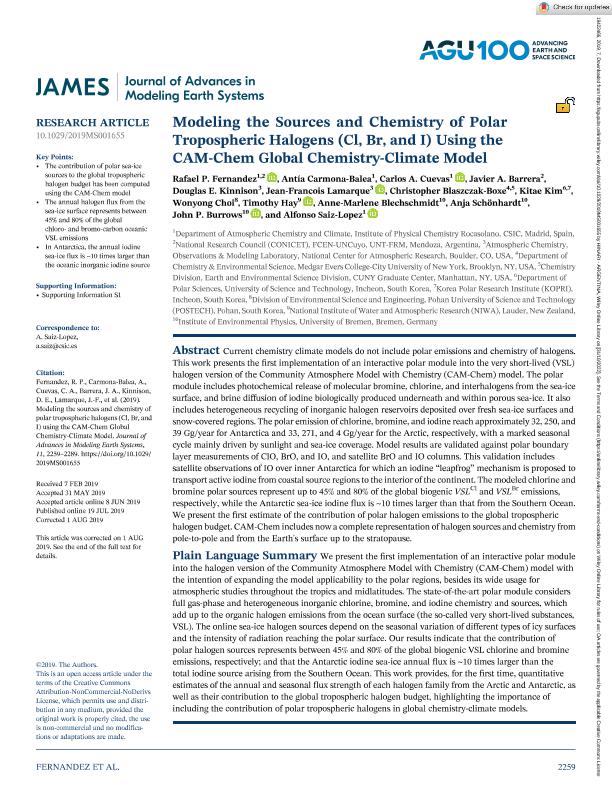Mostrar el registro sencillo del ítem
dc.contributor.author
Fernandez, Rafael Pedro

dc.contributor.author
Carmona Balea, Antía
dc.contributor.author
Cuevas, Carlos Alberto

dc.contributor.author
Barrera, Javier Alejandro

dc.contributor.author
Kinnison, Douglas E.

dc.contributor.author
Lamarque, Jean Francois
dc.contributor.author
Blaszczak Boxe, Christopher
dc.contributor.author
Kim, Kitae
dc.contributor.author
Choi, Wonyong
dc.contributor.author
Hay, Timothy
dc.contributor.author
Blechschmidt, Anne Marlene
dc.contributor.author
Schönhardt, Anja
dc.contributor.author
Burrows, John P.
dc.contributor.author
Saiz López, Alfonso

dc.date.available
2022-10-31T19:56:19Z
dc.date.issued
2019-06
dc.identifier.citation
Fernandez, Rafael Pedro; Carmona Balea, Antía; Cuevas, Carlos Alberto; Barrera, Javier Alejandro; Kinnison, Douglas E.; et al.; Modeling the Sources and Chemistry of Polar Tropospheric Halogens (Cl, Br, and I) Using the CAM-Chem Global Chemistry-Climate Model; American Geophysical Union; Journal of Advances in Modeling Earth Systems; 11; 7; 6-2019; 2259-2289
dc.identifier.issn
1942-2466
dc.identifier.uri
http://hdl.handle.net/11336/175694
dc.description.abstract
Current chemistry climate models do not include polar emissions and chemistry of halogens. This work presents the first implementation of an interactive polar module into the very short-lived (VSL) halogen version of the Community Atmosphere Model with Chemistry (CAM-Chem) model. The polar module includes photochemical release of molecular bromine, chlorine, and interhalogens from the sea-ice surface, and brine diffusion of iodine biologically produced underneath and within porous sea-ice. It also includes heterogeneous recycling of inorganic halogen reservoirs deposited over fresh sea-ice surfaces and snow-covered regions. The polar emission of chlorine, bromine, and iodine reach approximately 32, 250, and 39 Gg/year for Antarctica and 33, 271, and 4 Gg/year for the Arctic, respectively, with a marked seasonal cycle mainly driven by sunlight and sea-ice coverage. Model results are validated against polar boundary layer measurements of ClO, BrO, and IO, and satellite BrO and IO columns. This validation includes satellite observations of IO over inner Antarctica for which an iodine “leapfrog” mechanism is proposed to transport active iodine from coastal source regions to the interior of the continent. The modeled chlorine and bromine polar sources represent up to 45% and 80% of the global biogenic VSLCl and VSLBr emissions, respectively, while the Antarctic sea-ice iodine flux is ~10 times larger than that from the Southern Ocean. We present the first estimate of the contribution of polar halogen emissions to the global tropospheric halogen budget. CAM-Chem includes now a complete representation of halogen sources and chemistry from pole-to-pole and from the Earth's surface up to the stratopause.
dc.format
application/pdf
dc.language.iso
eng
dc.publisher
American Geophysical Union

dc.rights
info:eu-repo/semantics/openAccess
dc.rights.uri
https://creativecommons.org/licenses/by-nc-nd/2.5/ar/
dc.subject
CAM-CHEM MODEL
dc.subject
GLOBAL TROPOSPHERIC CHEMISTRY
dc.subject
POLAR HALOGEN CHEMISTRY
dc.subject
SEA-ICE HALOGEN EMISSIONS
dc.subject.classification
Geociencias multidisciplinaria

dc.subject.classification
Ciencias de la Tierra y relacionadas con el Medio Ambiente

dc.subject.classification
CIENCIAS NATURALES Y EXACTAS

dc.title
Modeling the Sources and Chemistry of Polar Tropospheric Halogens (Cl, Br, and I) Using the CAM-Chem Global Chemistry-Climate Model
dc.type
info:eu-repo/semantics/article
dc.type
info:ar-repo/semantics/artículo
dc.type
info:eu-repo/semantics/publishedVersion
dc.date.updated
2022-10-25T14:42:40Z
dc.journal.volume
11
dc.journal.number
7
dc.journal.pagination
2259-2289
dc.journal.pais
Estados Unidos

dc.description.fil
Fil: Fernandez, Rafael Pedro. Consejo Superior de Investigaciones Científicas. Instituto de Química Física "Rocasolano"; España. Universidad Nacional de Cuyo. Facultad de Ciencias Exactas y Naturales; Argentina. Universidad Tecnológica Nacional; Argentina. Consejo Nacional de Investigaciones Científicas y Técnicas; Argentina
dc.description.fil
Fil: Carmona Balea, Antía. Consejo Superior de Investigaciones Científicas. Instituto de Química Física "Rocasolano"; España
dc.description.fil
Fil: Cuevas, Carlos Alberto. Consejo Superior de Investigaciones Científicas. Instituto de Química Física "Rocasolano"; España
dc.description.fil
Fil: Barrera, Javier Alejandro. Universidad Nacional de Cuyo. Facultad de Ciencias Exactas y Naturales; Argentina. Consejo Nacional de Investigaciones Científicas y Técnicas; Argentina
dc.description.fil
Fil: Kinnison, Douglas E.. National Center for Atmospheric Research; Estados Unidos
dc.description.fil
Fil: Lamarque, Jean Francois. National Center for Atmospheric Research; Estados Unidos
dc.description.fil
Fil: Blaszczak Boxe, Christopher. City University of New York. Medgar Evers College; Estados Unidos
dc.description.fil
Fil: Kim, Kitae. Korea Polar Research Institute; Corea del Sur
dc.description.fil
Fil: Choi, Wonyong. Pohan University of Science and Technology; Corea del Sur
dc.description.fil
Fil: Hay, Timothy. National Institute of Water and Atmospheric Research; Nueva Zelanda
dc.description.fil
Fil: Blechschmidt, Anne Marlene. Universitat Bremen; Alemania
dc.description.fil
Fil: Schönhardt, Anja. Universitat Bremen; Alemania
dc.description.fil
Fil: Burrows, John P.. Universitat Bremen; Alemania
dc.description.fil
Fil: Saiz López, Alfonso. Consejo Superior de Investigaciones Científicas. Instituto de Química Física "Rocasolano"; España
dc.journal.title
Journal of Advances in Modeling Earth Systems
dc.relation.alternativeid
info:eu-repo/semantics/altIdentifier/url/https://onlinelibrary.wiley.com/doi/abs/10.1029/2019MS001655
dc.relation.alternativeid
info:eu-repo/semantics/altIdentifier/doi/http://dx.doi.org/10.1029/2019MS001655
Archivos asociados
